

| This mortuary temple is the standard Egyptian type with two pylons and two courtyards which precede the hypostyle hall; then the most sacred area is at the rear. None of these photographs give a view of the whole complex. The first pylon and the ruined first courtyard are never pictured on this site. The second pylon (only the north tower remains) is pictured at the bottom of this page and would be to the far left in the left photograph below. The temple is on an east-west axis with the sacred end (rear) to the west. See this site for a plan and aerial view. | ||
Left: view of the temple from the north including the second courtyard to the rear; right: from the southeast |
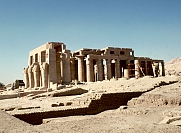
|

|
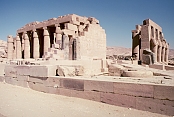
|
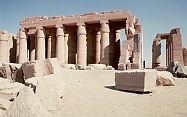
|
View from second courtyard to rear from southeast (left) and from south (right) |
Views of the portico and hypostyle hall from the second courtyard--three stairways rise to the portico or vestibule before the hypostyle hall |
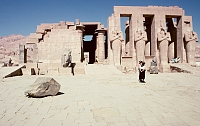
|
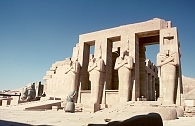
|
The front and back (or the east and west ends) of the second courtyard were lined with Osiris pillars. Only those on the north sides remain. The fallen fragments to the right of the north pylon are what remains of the colossal statue of the so-called Ozymandias, a corruption of one of Ramses II's names (User-maat-Re) by the first century BCE Greek historian Diodorus Siculus. (This is the same Ozymandias memorialized by the British romantic poet Shelley.) It would have been one of the largest free-standing statues in Egypt, an estimated 17 ½ meters (taller than the Colossi of Memnon).The back side of the north tower of the second pylon | ||
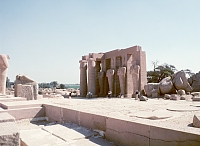
|
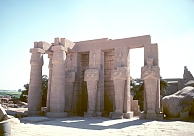
|
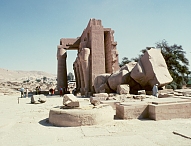
|
| The back surface of the north tower of the pylon depicts the Battle of Kadesh, a conflict occurring with the Hittites in Syria in the fifth year of Ramses II's reign. We see Ramses (larger than his men) dashing into battle and the dead and wounded lying chaotically on the ground (see below). | 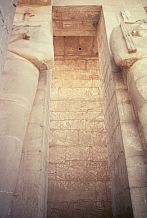
|
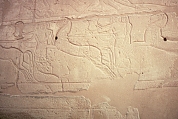
|

|
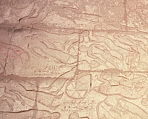
|
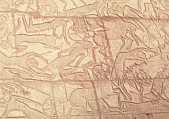
|
Unidentified reliefs: center: worshipping a goddess (Isis? Hathor?); right: ?I want to thank Gonzalo M. Sanchez M.D. who has written me to explain the man held upside down in the left-hand picture. He says "The scene is from the battle of Kadesh on the Second Pylon (like the rest of your pictures of this battle). He is the ruler of Aleppo, an ally of the Hittite King fighting against Ramesses II. The prince is being emptied out and resuscitated by Hittite infantry soldiers." | ||
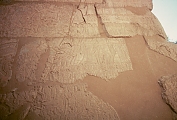
|
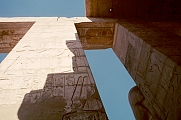
|
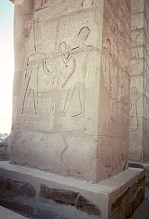
|
 Click here to go to the Egypt Index.
Click here to go to the Egypt Index.
 Click here to return to index of art historical sites.
Click here to return to index of art historical sites.
 Click here to return to index of artists and architects.
Click here to return to index of artists and architects.
 Click here to return to chronological index.
Click here to return to chronological index.
 Click here to see the home page of Bluffton College.
Click here to see the home page of Bluffton College.
